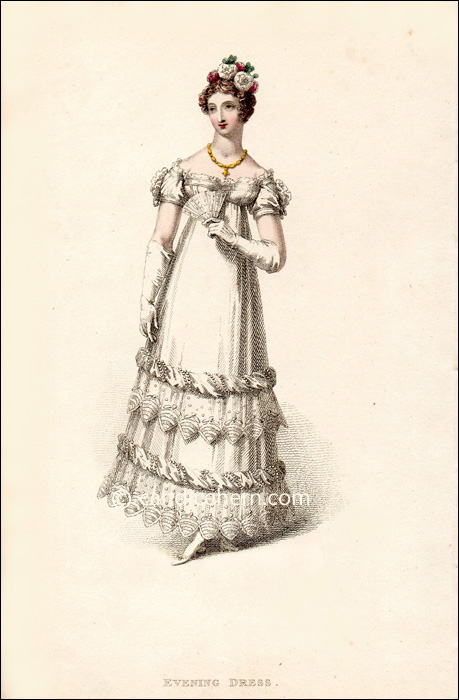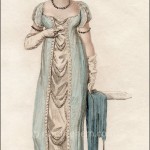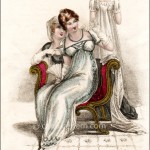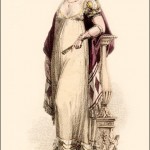Ackermann’s Repository of Arts, October 1817.
“Evening Dress”
The bell shape of the skirt and the slightly off-the-shoulder sleeves are an early hint of things to come in the next ten or fifteen years: more exaggerated bell-shapes and puffier sleeves falling well off the shoulder.
But for fashionable 1817, you see the very high waist and the very deep flounce.
The print is described in the magazine as follows:
“White British net dress over a soft white satin slip. The body is composed of white satin, disposed in folds, and rich letting-in lace. The sleeve, which is very short and full, is composed of the same materials: the lace is brought very full in front of the arm, and divided by tucks into full compartments, which are finished by small pearl tassels. For the form of the body, which is truly novel, we refer our fair readers to our print. The skirt is elegantly ornamented with two falls of broad rich blond, laid on almost plain; each fall is surmounted by a full rouleau of white satin, the fulness [sic] of which is confined by pearls twisted round it. The hair is turned up à la Grecque behind; it is parted in front so as to display the whole forehead, and disposed in light loose ringlets. Head-dress à la François, a full garland of roses and fancy flowers. Necklace and ear-rings, topaz mixed with pearl. White satin shoes. White kid gloves, and spangled crape fan.
“…We have again to acknowledge our obligations to Miss McDonald of 29, Great-Russell-street, Bedford-square, for both our dresses this month.”
In the section entitled General Observations on Fashion and Dress we find the following oblique references to this print:
“Crape and tulle are in much estimation for full dress, but British net is still more in request: these light materials are always worn over white satin. … In full dress, toques and turbans continue to be worn much as ever by matronly ladies, but youthful belles appear to give a preference to flowers …”








